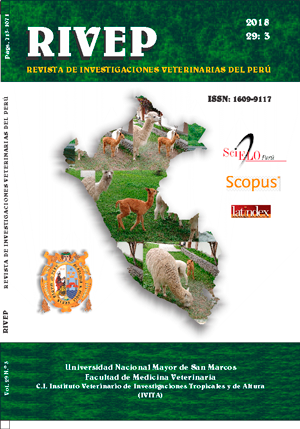Effect of the sanitary situation of the poultry house on the larval stages of endoparasites in the intermediate hosts and on the productive performance
DOI:
https://doi.org/10.15381/rivep.v29i3.14828Keywords:
larval states, endoparasite, Subulura suctoria, intermediate hosts, Alphitobius diaperinus, Forficula auriculariaAbstract
The objective of the study was to evaluate the effect of the health status of poultry houses on the prevalence of larval stages of endoparasites in intermediate hosts and on the productive behavior of 55-week-old White Leghorn laying hens for eight weeks. Two treatments were designed (T1 and T2) with 486 chickens each (three replicas of 162 birds), according to the hygienic quality of two chicken houses (dust levels in the floor, puddles in excreta towers, feathers and broken eggs in the floor and corridors, presence of wild birds, population of insects). Every 15 days (four samplings) 1 kg of excreta per replica was collected from the excreta towers to quantify and classify the intermediate hosts. All insects and arthropods were identified, and the presence of nematode larvae and larval cysts was quantified. The intestines of 15 birds (T1=7; T2=8) were collected for the identification of endoparasites. The extension of the infestation was determined, and the productive variables were estimated (production of total eggs and per bird, percentage of egg laying, conversion, viability, and external quality of the egg). The results indicated that the sanitary situation of the chicken house with poor hygienic conditions (T2) positively influenced the populations of intermediary hosts of cestodes and in a greater production of eggs with dirty, stained, and broken shells. Alphitobius diaperinus was the coleopter with the highest presentation and with the highest intensity of infestation by Subulura suctoria.Downloads
Downloads
Published
Issue
Section
License
Copyright (c) 2018 Gabriel Gorrín A., Manuel Colas C., Teresa Meireles R., Edmundo O. Pérez R.

This work is licensed under a Creative Commons Attribution-NonCommercial-ShareAlike 4.0 International License.
AUTHORS RETAIN THEIR RIGHTS:
a. Authors retain their trade mark rights and patent, and also on any process or procedure described in the article.
b. Authors retain their right to share, copy, distribute, perform and publicly communicate their article (eg, to place their article in an institutional repository or publish it in a book), with an acknowledgment of its initial publication in the Revista de Investigaciones Veterinarias del Perú (RIVEP).
c. Authors retain theirs right to make a subsequent publication of their work, to use the article or any part thereof (eg a compilation of his papers, lecture notes, thesis, or a book), always indicating the source of publication (the originator of the work, journal, volume, number and date).



